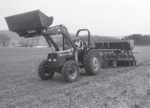Advertise Follow Us
Items Tagged with 'work'
ARTICLES
Take Two Cuts In One Pass
This Washington producer added a second cutter for more effective management of small grains residue.
Read More
Equipment Upgrades Possible Through Sharing Arrangements
Newer, bigger, more advanced equipment becomes available when you join with other no-tillers in clearly defined agreements covering costs and use.
Read More
What I've Learned from No-Tilling
After Nearly 25 Years, Improvements Still Keep Coming
An open mind welcomes a lot of ideas that, with a little tweaking, can deliver even more success to your fields.
Read More
Take the Next Step With Mature No-Till Fields
Long-term no-tillers earn rewards from improved soils, but they also face new questions as they try to make the most of their evolving fields.
Read More
What I've Learned from No-Tilling
Finding No-Till’s Weakest Link Is Essential
Having just one problem in a no-till system is enough to cause serious problems and it can happen at any time — even after 20 years of no-tilling.
Read More
What I've Learned from No-Tilling
Continuous No-Till Really Does Pay
While 23 percent of the country’s total cropland is now being no-tilled, less than 12 percent has been continuously no-tilled for more than 5 years.
Read More
What I've Learned from No-Tilling
No-Till Takes Less Inputs, Offers Higher Yields
Equipment use with no-till is so low that this Nebraska farmer doesn’t worry about higher fuel costs.
Read More











